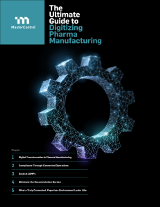
GxP Lifeline
Ultimate Guide Spotlights Pharma Manufacturing’s Transition to Digitization

The COVID-19-induced suspension of on-site regulatory inspections and the subsequent backlog of pharmaceutical product approvals compelled the U.S. Food and Drug Administration (FDA) to consider alternatives to site visits. Using the term “remote interactive evaluations,” the agency drafted a guidance explaining the policies, tools and processes it may employ to conduct remote oversight of pharmaceutical companies and products.1
Given the pace the pharmaceutical industry is moving, it’s important for organizations to stay up to date with industry trends. That said, “The Ultimate Guide to Digitizing Pharma Manufacturing” takes an in-depth look at how numerous pharma companies are adopting digitization in manufacturing as a way to ensure long-term relevance in the pharmaceutical value chain. This blog highlights some of the new trends and industry statistics presented in the guide.
A Digital Transformation in Pharma Manufacturing
In 2020, technology consulting company Cognizant surveyed 4,000 business leaders to gain insight into attitudes toward technology and the future of work. In part, the survey data indicated that modernized technologies, such as a pharma manufacturing execution system (MES), are becoming more mainstream in product development. “[The] research reveals that Internet of Things (IoT), artificial intelligence (AI), automation and data analytics will be at the core of the life sciences industry’s transformation, enabling intelligent decisions, unlocking innovation opportunities and building long-term operational resilience.”2
Connected Operations Boosts Pharma Compliance Success
Achieving compliance is required for putting a product on the market. Getting to that point without delays or setbacks keeps your organization on schedule and ahead of the competition. Pharma manufacturing software streamlines the collection and flow of data. Companies have a better understanding of how their shop floor is working, which leads to data-driven product- and process-related decisions.
The success of an enterprise's evolution partially depends on the connectivity of systems throughout the organization. For example, digitization in manufacturing enables staff to have access to more data on the factory floor. This empowers them to respond more quickly and decisively to nonconformances, deviations, corrective actions/preventive actions (CAPAs), etc.
Mastering cGMP Regulations
According to the FDA’s current good manufacturing practice (cGMP) guidelines, every pharmaceutical product has established identity, strength, purity, and other quality characteristics designed to ensure the required levels of product safety and effectiveness. Therefore, compliance with cGMP means that the manufacturer can consistently produce the same product over and over again.
Because cGMPs continue to evolve, manufacturers need to deploy a pharma MES on the shop floor. For example, automated, real-time quality review at each step on the production line helps ensure lots are right the first time. Digital technologies, along with all relevant data and analytics will foster innovation, enhance efficiency, and create more value propositions.
Shedding the Manufacturing Paper Burden
One of the biggest causes of delays in batch releases is related to the quality function — specifically, missing batch information. The review and clarification processes are cumbersome as they commonly involve two or three reviews by different staff members. In pharma manufacturing, approximately 30% of staff time is spent on documentation-related activities.3 This is non-productive time because it often results in companies bolstering their quality control efforts by pulling staff from other business-critical tasks.
Going paperless reduces errors and missing information on batch records, helping ensure right-first-time product output. Download the “Ultimate Guide to Digitizing Pharma Manufacturing” to learn more about the pharmaceutical industry’s transformation toward modernization.
References:
- “Remote Interactive Evaluations of Drug Manufacturing and Bioresearch Monitoring Facilities During the COVID-19 Public Health Emergency,” U.S. Food and Drug Administration (FDA), April 2021.
- “The Work Ahead in Life Sciences: Cures at the Speed of Digital,” Brian Williams, Cognizant.
- “Operations Can Launch the Next Blockbuster in Pharma,” Ulf Schrader, McKinsey & Company, Feb. 16, 2021.

